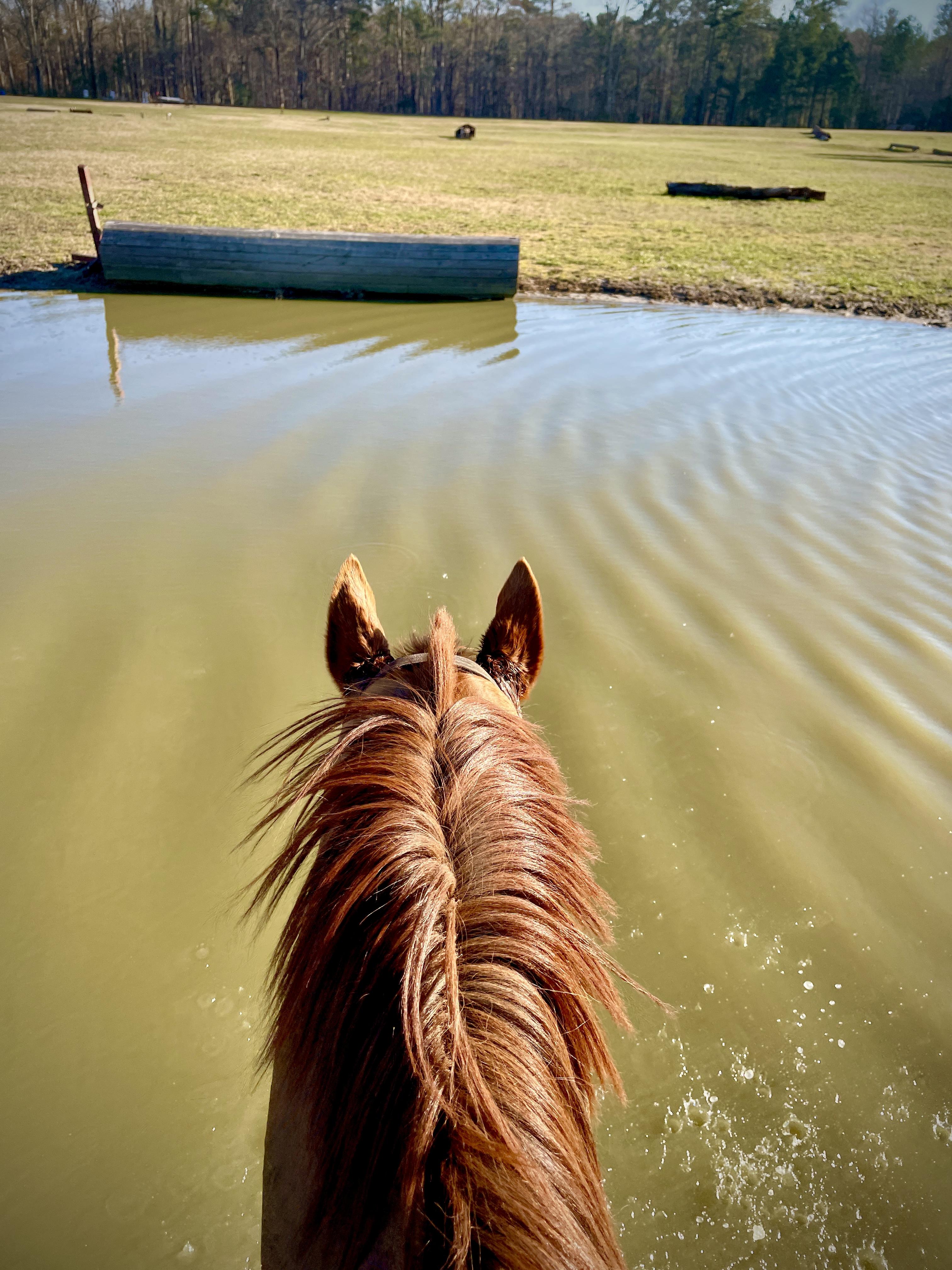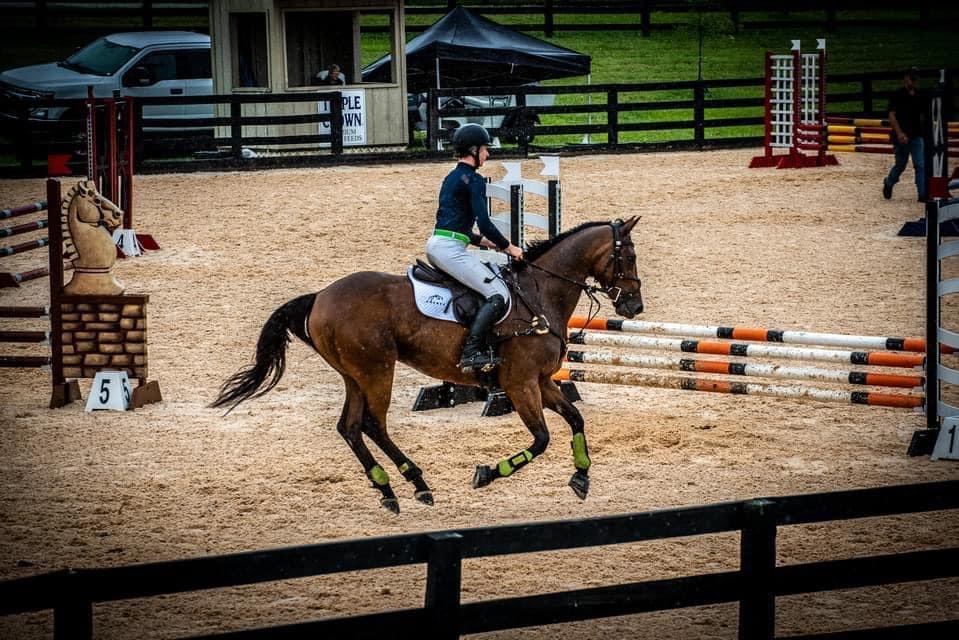
Thoroughbred Logic: Go Forward.
“The only way forward is through, the only way through is forward.” In this week’s Thoroughbred Logic, Aubrey Graham discusses the importance of going forward.
Welcome to the next installment of Thoroughbred Logic. In this weekly series, Anthropologist and trainer Aubrey Graham, of Kivu Sport Horses, will offer insight and training experience when it comes to working with Thoroughbreds (although much will apply to all breeds). Come along for the ride as she discusses her logic on moving forward.
You have to go forward.
This applies to so many things with horses – and particularly, with Thoroughbreds. Figuratively, this is the “just keep swimming” adage. I remind myself of this every time there is a training issue, a one step forward seven steps back, stall rest (here’s looking at you Crafty), a looming vet bill or the like. On Monday, I also had to remind Seeker (JC Hot to Seek Her) of this concept as he hemmed and hawed at a water crossing on a trail ride. Sorry buddy — you guessed it — the only way through is forward.

Seeker figured out going “forward through stream” and then made short work of the XC water at Ashland Farm. Photo by author.
The importance of ‘forward’ applies in the arena as well: To develop a good rhythm and come ‘through’ – as in getting a horse to push from behind and come over their back – one must also go forward.
While Thoroughbreds are trained to break from the gate and run really damn fast for six to 12 furlongs (3/4 to 1.5 miles), their muscling on-track is frequently different than what they need/will develop for sport, off-track. Certainly, some make the right ‘shape’ and move smoothly over their topline as they transition into their second careers. Most, however, have to (re)learn how to carry themselves – they cannot initially get ‘round’ and stay in front of your leg while going super slowly. They must go forward.
I have always trained a horse to go forward (first) in order to collect (later). I’m certain there are other ways to do it, but in my version, I regularly end up laughing while yelling at students, “Faster, you have to go faster.” This patently does not mean that they should scramble or run, but rather that they need to use their horse’s innate ‘let’s go’ drive to attain a more engaged walk, trot, or canter. This form of ‘forward’ helps develop a steadier rhythm from which one can work towards hind-end engagement.

Rhodie showing off his early sporthorse body after six-months of retraining. Photo by Kelly Robison.
For each horse, the number of rides necessary to understand this “forward-to-get-through” varies. Among others things, factors such as age, quality of training on the track, condition of their body, saddle fit, and comfort of their feet, matter. Patience and forward-going persistence are key.
Boomer (Vanderboom Ridge, 2011) and Regazze (Regazze Cat 2011) had the concept nailed by the end of their first post track rides and have never looked back. For Fletcher (Reflection, 2014), it took one hack stuck behind my leg for him to figure ‘forward’ out. In contrast, there was West (Western Conqueror 2012), a stallion we had here for six-weeks a while back. Under saddle, he was super sucked back and balky. For two of those weeks we had to really — and I mean really — push him out down the long sides for him to learn to come get in front of my leg and come through. Super sensitive Cheese (RW’s Retirement, 2016) has the forward part down pat, but is still figuring out how to relax, settle, and use his back. They are all different.
Regardless of the amount of time this takes, the ‘go forward’ method carries another benefit – it helps nix the initial rider micromanagement aimed at “slow and forcibly round.” Getting a horse’s head down alone does not do much. Instead of pulling down with low hands or seesawing contact, going forward allows the ‘through’ to come from the hind end as a rider sits tall, lifts the hands, and rides the horse up into soft, elastic contact.
“Chicken” (My Vow is Courage, 2017) is partway through learning this process and therefore, makes a convenient example. The first post-track ride saw him find a good rhythm. With a little encouragement, he moved forward and got in front of my leg while remaining quiet. Chicken is not a particularly sensitive, flighty soul, and he would have happily puttered around on the buckle behind my leg if I let him. By driving him forward, I was able to get his hind end under him and from there, I could feel him start to push from behind. Good Chicken! I didn’t care that his head was in the air.

Chicken trots around nice and forward during his first post track ride. Photo by Audrey Mecklenburg.
By ride three, Chicken was starting to move forward off my leg with ease. By ride four and five, he spent most of the saddle time experimenting with where his head and neck should be — he’d come round for a few strides, bob his head, put it back up, come low and through for 10 more strides, and repeat. Part of this is about strength — chunky Chicken is having to do a horse-version of pilates at the moment. The other part of this is him learning that when his hind end is under him and he is moving forward in an uphill balance, his body is most comfortable when round.
 Chicken experiments with ‘forward and through’ during his fifth post-track ride. Photo by Audrey Mecklenburg.
Chicken experiments with ‘forward and through’ during his fifth post-track ride. Photo by Audrey Mecklenburg.
Sure, right now Chicken is not able to hold this posture for long. That said, with each ride, he gets better – more consistently forward, through, and soft in the contact. Give him another couple weeks, and he will look like a different, stronger, rounder, more capable sporthorse. I’m super excited to be aboard for at least this portion of his progress.
And so, in a summarizing play on words, ‘the only way forward is through, the only way through is forward.’ Seeker got to figure out the first half at a dreaded stream crossing. Chicken gets to learn the second half by riding forward and up over his back. I suppose it works. Either way, you just have to go forward.







